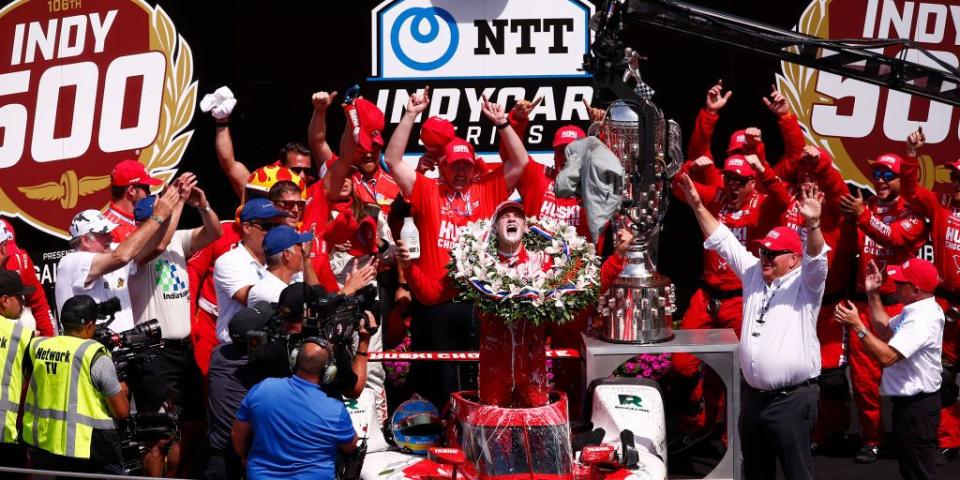Marcus Ericsson Wins Dramatic Indianapolis 500

Marcus Ericsson blended into the scenery for the first couple years of his IndyCar career. The five-year F1 driver with Caterham and Sauber had just one podium in his first two seasons in the series, first with Schmidt Peterson and then with his current team Chip Ganassi Racing. Then, in 2021, he seemed to figure it out: Two wins, consistent top ten finishes, and a very respectful sixth in the series championship. In 2022, he's been even better. Despite that, he was the least-buzzed-about name in the entire Fast 12 after qualifying.
That changed in a big way today.
In the first half of the race, though, Ericsson was a non-factor. The two lead Ganassi cars, pole-sitter Scott Dixon and reigning series champion Alex Palou, traded the lead throughout the first two stints before Palou's race was derailed completely by a caution that came out as he was passing through the pit lane. In that stretch, their biggest threat came from Rinus VeeKay of Ed Carpenter Racing; he spun and crashed early, ending his race.
That left Dixon to contend with a collection of Chevrolets as the lone Honda up front throughout the middle of the race. Conor Daly led a few laps for Ed Carpenter Racing. Pato O'Ward's McLaren led a few, too. But it was Dixon that was the clear strongest car in the field throughout the race and, when a yellow came out with just under 50 to go, the stage seemed set for him to battle O'Ward for the race win. On the restart, they traded the spot twice on a charge to the final pit stop of the day.
Then, disaster.
Dixon was caught speeding on pit entry, ending what at times looked like it was going to be the single most dominant win at this track since the current turbo V-6 and DW12 chassis were introduced in 2012. He finished a distant 21st.
Felix Rosenqvist, who had undercut teammate Pato O'Ward, inherited the lead. O'Ward got past his McLaren teammate quickly, but Marcus Ericsson made short work of both of them laps later. Through traffic that had yet to pit, Ericsson built what was at one point a nearly four second lead. Then, Jimmie Johnson crashed in turn 3 with six laps to go. The red flag was displayed, guaranteeing a final restart and a two-lap race to the finish.
O'Ward had cut into Ericsson's lead in clean air, but it was still a 2.8-second lead. In that instant, it was gone. That set up the signature moment of Ericsson's entire career to date.
RETWEET to congratulate @Ericsson_Marcus on winning the #indy500! pic.twitter.com/6eJt9Dk3VT
— #Indy500 on NBC (@IndyCaronNBC) May 29, 2022
Ericsson held off O'Ward on the restart. Then, with four snaking block moves in one straight, he held off O'Ward into 3. O'Ward actually got his nose ahead of Ericsson into turn 1 on the final lap, but another earlier snaking block move that actually briefly saw Ericsson in line with the pit lane entrance was enough to keep that run down; O'Ward had to relent in the corner and he again pulled away. By the time the caution was out for a crashing Sage Karam, he had successfully defended the position from any final attack already.
Ericsson is the second Swedish winner of the Indianapolis 500. It is his first win on an oval of any sort, too. With two 500 winners, the current series champion, and the most successful NASCAR driver of the decade in the same stable, he entered as the fifth-most famous Chip Ganassi Racing driver in the field; he'll leave as a 500 champion himself.
The win is also enormous in his hunt for a first career IndyCar championship. He and runner-up O'Ward were the biggest beneficiaries of the race's double points format, all-important in the battle for the series title. Tony Kanaan, third in what may be his last 500 if he cannot get a program together for what he said post-race would be his planned final race next year, created an additional buffer for both from the rest of the field. Felix Rosenqvist and Alexander Rossi, both finishing in the top five, also gained significant championship position. Alex Palou, Josef Newgarden, and Will Power, all of whom who recovered from pit lane disasters to finish ninth, 13th, and 15th respectively, can call the day a relative wash.
The unlucky were Scott Dixon (21st), Scott McLaughlin (29th), Colton Herta (30th), Romain Grosjean (31st) and Rinus VeeKay (33rd). Dixon's penalty came far too late to really recover. Grosjean, VeeKay, and McLaughlin all crashed in single-car incidents. Herta's race never really got going, struggling with speed all day in a back-up car hastily assembled after a terrifying crash in Friday's Carb Day practice. All five are now in a major championship hole, one they'll have to start erasing when the IndyCar Series heads to Detroit next weekend.
You Might Also Like

 Yahoo Autos
Yahoo Autos 